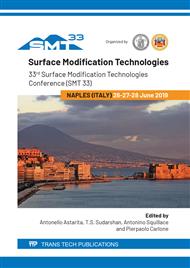[1]
A. Alunni, E. Cerri, E. Evangelista, A. Forcellese, Temperature and strain rate effect on hot formability of 6061+20 vol.% SiC whiskers, Proceedings of International Conference on Advanced Composites (1993) 1079-1085.
Google Scholar
[2]
A.M. De Sanctis, E. Evangelista, A. Forcellese, Y.Z. Wang, Hot formability studies on 359/SiC/20p and their application in forging optimisation, Appl. Compos. Mater. 3 (1996) 179-198.
DOI: 10.1007/bf00135055
Google Scholar
[3]
S.M. Roberts, J. Kusiak, Y.L. Liu, A. Forcellese, P.J. Withers, Prediction of damage evolution in forged aluminium metal matrix composites using a neural network approach, J. Mater. Process. Technol. 80-81 (1998) 507-512.
DOI: 10.1016/s0924-0136(98)00153-8
Google Scholar
[4]
M. Holmes, Carbon fibre reinforced plastics market continues growth path, Reinf Plast 57 (2013) 24–29.
DOI: 10.1016/s0034-3617(13)70186-3
Google Scholar
[5]
A. D'Orazio, M. El Mehtedi, A. Forcellese, A. Nardinocchi, M. Simoncini, Tool wear and hole quality in drilling of CFRP/AA7075 stacks with DLC and nanocomposite TiAlN coated tools, J. Manuf. Process. 30 (2017) 582–592.
DOI: 10.1016/j.jmapro.2017.10.019
Google Scholar
[6]
A. D'Orazio, M. El Mehtedi, A. Forcellese, A. Nardinocchi, M. Simoncini, Study of tapping process of carbon fiber reinforced plastic composites/AA7075 stacks, AIP Conference Proceedings 1960 (2018) 070010.
DOI: 10.1063/1.5034906
Google Scholar
[7]
N.E. Prasad, R.J.H. Wanhill, Aerospace materials and material technologies. Volume 1, Aerospace materials.
Google Scholar
[8]
S.S. Wicks, R.G. de Villoria, B.L. Wardle, Interlaminar and intralaminar reinforcement of composite laminates with aligned carbon nanotubes, Compos Sci Technol 70 (2010) 20–28.
DOI: 10.1016/j.compscitech.2009.09.001
Google Scholar
[9]
D. He, D. Salem, J. Cinquin, G.P. Piau,J. Bai, Impact of the spatial distribution of high content of carbon nanotubes on the electrical conductivity of glass fiber fabrics/epoxy composites fabricated by RTM technique, Compos Sci Technol 147 (2017) 107–115.
DOI: 10.1016/j.compscitech.2017.05.012
Google Scholar
[10]
Q. Zhang, Carbon nanotubes and their applications, Pan Stanford Publishing (2012).
Google Scholar
[11]
A.C. Loos, M.W. Hyer, American Society for Composites. Manufacturing of composites.
Google Scholar
[12]
M. Fogel, P. Parlevliet,M. Geistbeck,P. Olivier, E. Dantras,Thermal, rheological and electrical analysis of MWCNTs/epoxy matrices, Compos Sci Technol 110 (2015) 118–125.
DOI: 10.1016/j.compscitech.2015.02.002
Google Scholar
[13]
A. Terenzi, M. Natali, R. Petrucci, M. Rallini, L. Peponi, M. Beaumont, Analysis and simulation of the electrical properties of CNTs/epoxy nanocomposites for high performance composite matrices, Polym Compos 38 (2017) 105–115.
DOI: 10.1002/pc.23565
Google Scholar
[14]
A. Mamoune, A. Saouab, T. Ouahbi, C.H. Park, Simple models and optimization of compression resin transfer molding process, J Reinf Plast Compos 30 (2011) 1629–1648.
DOI: 10.1177/0731684411421539
Google Scholar
[15]
D. Abliz, G. Ziegmann, Y.G. Duan, D.C. Li, D. Meiners, Effect of CNT Concentration on Mechanical Properties of Composites Manufactured By Compression Resin Transfer Molding (CRTM ) (2014) 22–26.
Google Scholar
[16]
H. Lee, S. Mall, P. He, D. Shi, S. Narasimhadevara, Y.H. Yun, Characterization of carbon nanotube/nanofiber-reinforced polymer composites using an instrumented indentation technique, Compos Part B Eng 38 (2007) 58–65.
DOI: 10.1016/j.compositesb.2006.04.002
Google Scholar
[17]
A. El Moumen, M. Tarfaoui, K. Lafdi, Mechanical characterization of carbon nanotubes based polymer composites using indentation tests, Compos Part B Eng 114 (2017) 1–7.
DOI: 10.1016/j.compositesb.2017.02.005
Google Scholar
[18]
K.K. Panchagnula, P. Kuppan, Improvement in the mechanical properties of neat GFRPs with multi-walled CNTs, J Mater Res Technol (2018) 1–11.
DOI: 10.1016/j.jmrt.2018.02.009
Google Scholar
[19]
P.M. Nagy, D. Aranyi, P. Horváth, P. Pötschke, S. Pegel, E. Kálmán, Nanoindentation Investigation of Carbon Nanotube–Polymer Composites, Internet Electron J Mol Des (2006).
Google Scholar
[20]
S.G. Advani, K.T. Hsiao, Manufacturing techniques for polymer matrix composites (PMCs), Woodhead Pub (2012).
DOI: 10.1533/9780857096258.1.1
Google Scholar


